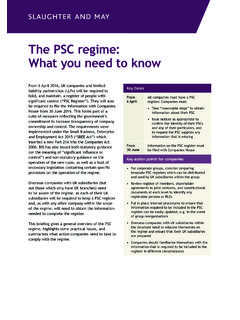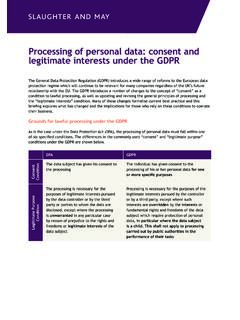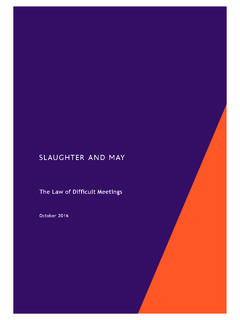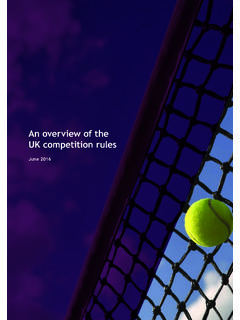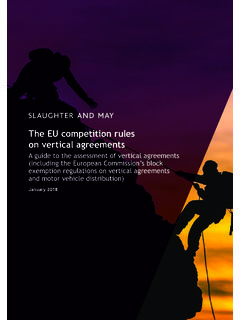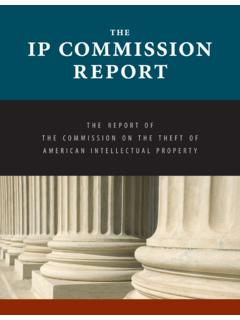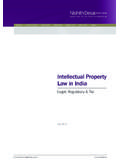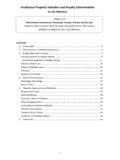Transcription of The EU competition rules on intellectual property ...
1 The EU competition rules on intellectual property licensingA guide to the European Commission s Technology Transfer Block Exemption Regulation and competition issues relating to IP licensing and enforcementJune 2016 / The EU competition rules on intellectual property licensingContents1. intellectual property rights and EU competition law 12. Technology transfer agreements and the TTBER 33. The safe harbour of the TTBER and the three-stage analysis 64. Withdrawal and disapplication of the TTBER 125. Assessment outside the TTBER 136.
2 Article 102 (abuse of a dominant position) 171 / The EU competition rules on intellectual property licensing1. intellectual property rights and EU competition intellectual property rights (IPRs) confer an exclusive legal right on the owner to exploit the patent, copyright, design right, trade mark or other IPR in question. The IPR owner is unilaterally able to prevent unauthorised use of its intellectual property and has a monopoly over whether to exploit it itself or through licensing to third When considering IPRs within the framework of EU law, the following two sets of rules are relevant: The competition rules : EU competition law aims to protect competition in markets throughout the EU and reduce barriers to cross-border trade, with a view to promoting the efficient use and dissemination of goods and services.
3 Although these objectives may sometimes appear at odds with the aims of intellectual property laws (which seek to encourage and reward innovation by IPR owners), both EU competition law and intellectual property legislation share broadly the same basic policy objectives of promoting consumer welfare and ensuring the efficient allocation of resources. The main EU competition rules are contained at Article 101 of the Treaty on the Functioning of the European Union (TFEU), which prohibits anti-competitive agreements, and Article 102 TFEU, which prohibits the abuse of a dominant position.
4 Since the licensing of IPRs is brought about by means of agreements, Article 101 is the principal instrument for regulating such forms of collaboration from a competition law perspective. Although EU competition policy accepts that some contractual limitations on the parties are necessary to protect IPRs, other restrictions can raise competition concerns. In exceptional cases, the way in which a company exploits its IPRs may also raise Article 102 issues, for example if competitors seeking to develop activities on a market that is dominated by a particular undertaking cannot do so unless they are granted access to essential IPRs owned by that dominant undertaking ( by being granted licences to relevant patents or copyright material).
5 The European Courts have considered the circumstances in which a refusal to license can constitute an abuse in a number of important cases and these are discussed towards the end of this publication. The rules on free movement of goods: Articles 34 to 36 TFEU prohibit Member States from imposing unjustified barriers to cross-border trade. While Article 36 permits the adoption of legislation by Member States to protect IPRs, this is subject to the limitations imposed by the Treaty s free movement objectives. The European exhaustion of rights principle means that IPRs cannot be enforced to prevent the marketing of goods in one Member State if those goods have previously been marketed in another Member State by, or with the consent of, the owner of the relevant This publication considers the application of the EU competition rules to the exploitation of IPRs through the granting of licence agreements to third parties.
6 Such agreements, particularly exclusive licences, often impose restrictions on how the licensee can exploit the IPRs that may be caught by Article 101(1) (and may therefore be unenforceable unless they satisfy the exemption criteria of Article 101(3)); in some cases, they may even raise issues under Article The EU competition rules on intellectual property licensing / The Technology Transfer Block Exemption Regulation (TTBER) sets out the basis for exemption of agreements relating to certain technology (essentially patents, proprietary know-how, software copyright and certain design rights ), offering a safe harbour from the prohibition contained in Article 101(1).
7 1 The current TTBER came into force on 1 May 2014. It is accompanied by a detailed set of guidelines (Technology Transfer Guidelines) that explain the Commission s approach to the licensing of IPRs under Article 101, including an assessment of how the TTBER applies and how agreements that do not meet the criteria set out in the TTBER should be analysed when applying Article The Technology Transfer Guidelines, which are binding on the Commission, are an essential point of reference in assessing the legality of restrictions contained in licence agreements outside the safe harbour of the TTBER.
8 1 Commission Reg. (EU) 316/2014 (OJ 2014 L93/17, ).2 Guidelines on the application of Art. 101 of the Treaty on the Functioning of the European Union to technology transfer agreements (OJ 2014 C89/03, ).3 / The EU competition rules on intellectual property licensing2. Technology transfer agreements and the TTBERF eatures of technology transfer Technology transfer agreements usually involve the grant by the IPR owner (the licensor) of a licence to a third party (the licensee) authorising the licensee to exploit the IPRs by manufacturing, marketing and selling certain goods or services (the contract products).
9 The TTBER applies to agreements concerning technology rights including software copyright, design rights , utility models, patents and/or know-how. The licensing of trade marks, copyright or other IPRs is not covered by the TTBER unless it is directly related to the production or sale of the contract Technology transfer agreements have a number of special features: they involve the licensing of IPRs, usually in return for the payment of royalties ( on a per unit or lump sum basis). The licensee acquires the right to manufacture the goods or otherwise use the licensor s technology.
10 The licensor therefore needs to exercise a certain amount of continuing control over the licensee to safeguard its IPRs; they differ from true assignments of IPRs, under which ownership is transferred completely to another party (often in exchange for a single upfront payment).3 An assignor or vendor of IPRs generally has less scope to restrict the purchaser s use of the rights transferred; and they can bring about a cross-fertilisation of ideas, insofar as the licensee may further develop the technology. This can result in the parties subsequently cross- licensing their respective IPRs and possibly granting licences to third The TTBER is only available for technology transfer agreements between two parties.


